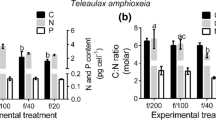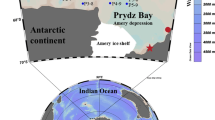Abstract
Planktonic ciliates, most importantly tintinnids and oligotrichs (subclass Choreotrichia), are important components of the micro-plankton in coastal waters1. At times, the biomass of ciliates is equivalent to the biomass of larger zooplankters2. The role of ciliates as grazers has been recognized (see ref. 3 for review), but their role as chloroplast-bearing cells has not been widely appreciated4. Many planktonic oligotrichs are pigmented because they sequester chloroplasts derived from a variety of chromophytic algae5–7. We report the first quantitative data on the frequency of chloroplast retention among planktonic oligotrichs and tintinnids. In surface waters during the spring and summer, approximately 42% of the planktonic ciliates have chloroplasts. During the autumn and winter, chloroplast-retaining species are less abundant, but still constitute at least 10% of the combined tintinnid and oligotrich fauna. Water samples containing large numbers of pigmented ciliates have a high chlorophyll content8 and fix carbon9. Although it has been speculated that sequestered chloroplasts in ciliates are functional5–7, we have demonstrated photosynthesis by chloroplast-containing ciliates experimentally. The trophic position of ciliates in planktonic food webs needs to be reconsidered.
Similar content being viewed by others
References
Beers, J. R., Reid, F. M. H. & Stewart, G. L. Mar. Biol. 60, 209–226 (1980).
Smetacek, V. Mar. Biol. 63, 1–11 (1981).
Verity, P. G. Mar. Ecol. Prog. Ser. 29, 105–115 (1986).
Elbrachter, M. in Flows of Energy and Materials in Marine Ecosystems (ed. Fasham, M. J. R.) 191–222 (Plenum, New York, 1984).
Blackbourn, D. J., Taylor, F. J. R. & Blackbourn, J. J. Protozoology 20, 286–288 (1973).
Laval-Peuto, M. & Febvre, M. Biosystems 19, 137–158 (1986).
McManus, G. B. & Fuhrman, J. A. J. Plank. Res. 8, 317–327 (1986).
Holm-Hansen, O., Taylor, F. J. R. & Barsdate, R. J. Mar. Biol. 7, 37–46 (1970).
Burkholder, P. R., Burkholder, L. M. & Almodovar, L. R. Bull. Mar. Sci. Gulf Caribb. 17, 1–15 (1967).
Gifford, D. J. Mar. Ecol. Prog. Ser. 23, 257–267 (1985).
Eldridge Tide and Pilot BooK 1986 (Robert Eldridge White, Boston, 1985).
Stoecker, D., Guillard, R. R. L. & Kavee, R. M. Biol. Bull. mar. biol. Lab., Woods Hole 160, 136–145 (1981).
Rivkin, R. B. & Seliger, H. H. Limnol. Oceanogr. 26, 780–785 (1981).
Li, W. K. W. & Goldman, J. C. Microbiol. Ecol. 7, 113–121 (1981).
Author information
Authors and Affiliations
Rights and permissions
About this article
Cite this article
Stoecker, D., Michaels, A. & Davis, L. Large proportion of marine planktonic ciliates found to contain functional chloroplasts. Nature 326, 790–792 (1987). https://doi.org/10.1038/326790a0
Received:
Accepted:
Published:
Issue Date:
DOI: https://doi.org/10.1038/326790a0
- Springer Nature Limited
This article is cited by
-
Spring Distribution of Ciliate Plankton in the Southeastern Yellow Sea in 2019
Ocean Science Journal (2021)
-
Single cell genomics yields a wide diversity of small planktonic protists across major ocean ecosystems
Scientific Reports (2019)
-
A survey of ciliates at the long-term sampling station “Helgoland Roads”, North Sea
Helgoland Marine Research (2014)
-
The acquisition of phototrophy: adaptive strategies of hosting endosymbionts and organelles
Photosynthesis Research (2011)
-
Adaptive characteristics of a ciliateTetrahymena thermophila in endosymbiotic association with a green algaChlorella vulgaris derived in a long-term microcosm culture
Symbiosis (2009)





